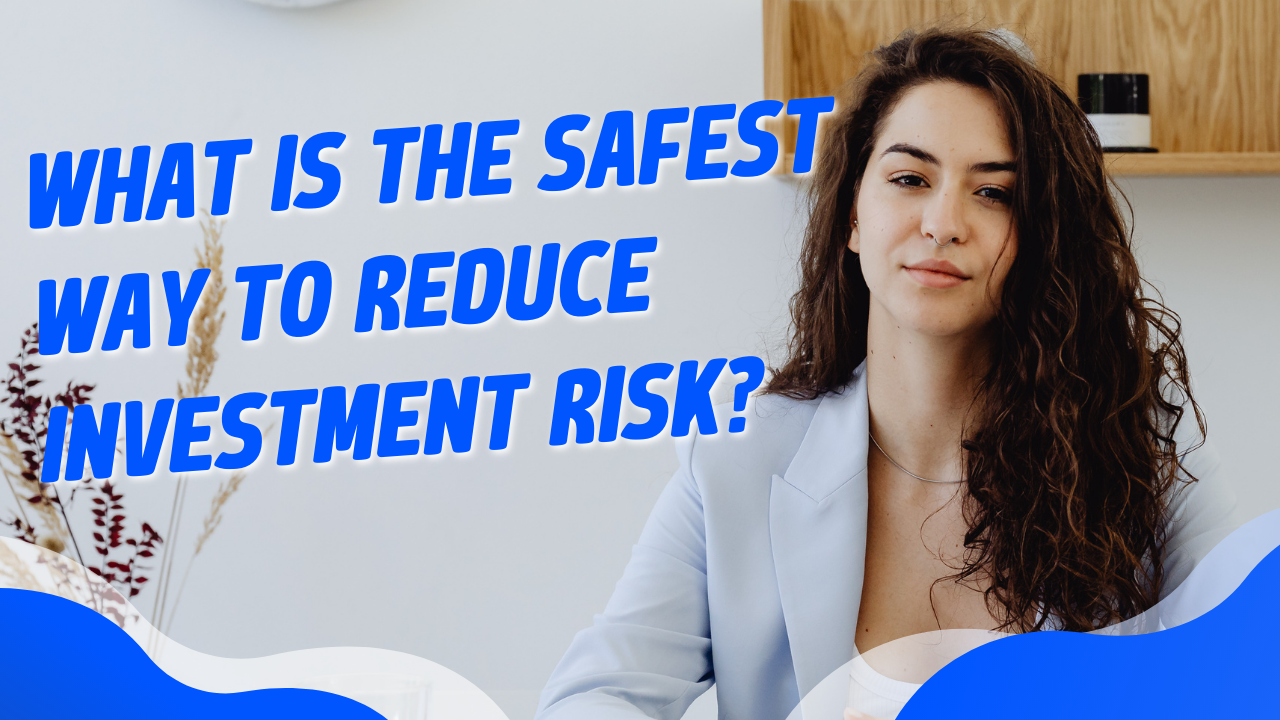Growing your wealth over time can be achieved through investing, but it’s important to acknowledge that every investment comes with a certain level of risk. Whether you’re a novice or an experienced investor, it’s crucial to comprehend the possible risks and learn how to mitigate them to safeguard your earnings.
Read about Alternative Investment Funds: What Are They, and Who Regulates AIF?

The key to mitigating investment risk isn’t to evade it entirely. Rather, it involves managing risk in a manner that reduces the likelihood of incurring significant losses while still permitting chances for profitable returns. This article will delve into some of the most secure methods for minimizing investment risk and safeguarding your portfolio.
So, let’s dive into the safest ways to reduce investment risk.
Diversify your portfolio
- Invest in different asset classes:Diversifying your portfolio means investing in a variety of asset classes, such as stocks, bonds, and real estate. Each asset class has its own risks and rewards, so spreading your investments across different classes can help you reduce your overall risk exposure.
- Invest in different industries:Investing in a variety of industries can also help reduce your risk. For example, if you invest heavily in the tech industry and there’s a sudden downturn in that sector, your portfolio could suffer. However, if you also have investments in healthcare, energy, and consumer goods, those sectors may not be affected in the same way, helping to balance out your overall portfolio.
- Invest in different geographic regions: Investing in different geographic regions can also help reduce your risk. If you have all your investments in one country or region, your portfolio could be vulnerable to political or economic turmoil in that area. By investing in different regions, you can spread your risk and minimize the impact of any one region’s economic or political issues.
- Rebalance regularly: Diversifying your portfolio is not a one-time event. You need to regularly review and rebalance your investments to ensure they continue to align with your overall investment strategy. If one asset class or industry becomes overrepresented in your portfolio, you may need to adjust your investments to restore balance.
Tap here to know Everything you Should Know About Cryptocurrency Portfolios
Consider index funds and ETFs
- Investing in index funds and ETFs is a secure way to mitigate investment risks.
- These investment vehicles follow a designated market index, such as the S&P 500, and diversify their holdings across a wide range of stocks or other assets.
- Investing in index funds or ETFs provides a more diversified investment that spreads out risk across many different stocks or assets.
- This approach can also result in lower fees compared to investing in individual stocks or mutual funds.
- Passive investors who want to minimize the time and effort spent on managing their investments may find index funds and ETFs particularly suitable.
- Investing in these funds allows you to reap the benefits of the market’s overall growth and performance, without the need to concern yourself with individual stock selection or market timing.
Running Out of Funds? Get to know how to Apply for Business Loans at Lower Interest Rates
Understand your risk tolerance
- Understanding your risk tolerance is an important factor in investing, as it determines how much risk you’re comfortable taking on in your investment portfolio.
- There are multiple factors that can affect your risk tolerance, such as your age, financial circumstances, investment objectives, and individual preferences.
- Some investors tend to be risk-averse and choose secure and conservative investments, while others exhibit a greater risk tolerance and are willing to invest in high-risk options that offer the potential for higher returns.
- It’s important to invest according to your risk tolerance, as investing in assets that are too risky or too conservative can result in lower returns or increased losses.
- If you find that your investment portfolio is causing you stress or discomfort due to its level of risk, you may need to adjust your investments to better align with your risk tolerance.
- For example, you may consider diversifying your portfolio to reduce risk, or investing in lower-risk assets such as bonds or cash equivalents.
- Ultimately, understanding your risk tolerance can help you make more informed investment decisions that align with your personal goals and preferences.
Stay informed and stay the course
- Staying informed about market trends and economic indicators is important for making informed investment decisions.
- However, it’s equally important to avoid making knee-jerk reactions to short-term market fluctuations that can lead to emotional, irrational decisions.
- Instead, it’s important to stay the course and focus on your long-term investment goals.
- This means having a solid investment strategy that aligns with your goals and risk tolerance, and sticking to it even during periods of market volatility.
- For example, if your investment strategy is focused on long-term growth, you may choose to ride out short-term market fluctuations, rather than selling off assets in a panic.
- By staying focused on your long-term goals, you can avoid the temptation to make impulsive decisions based on short-term market movements.
- Remember, the stock market has historically recovered from downturns, and staying invested can help you benefit from long-term market growth.
- That said, it’s also important to regularly review and adjust your investment strategy as needed based on changes in your financial situation or investment goals.
Also read:
What percentage of my investments should I put in mutual funds?
FAQs
How does inflation affect investment risk?
Inflation can erode the purchasing power of your investments over time, which increases the risk that you won’t be able to meet your financial goals. This is why it’s important to choose investments that keep pace with inflation.
Are there any tax implications to reducing investment risk?
There can be tax implications to reducing investment risk, such as if you sell an investment at a loss to reduce risk, you may be able to offset capital gains and reduce your tax liability.
Should I invest in individual stocks or mutual funds?
This depends on your individual goals, risk tolerance, and investment strategy. Generally, mutual funds offer greater diversification and lower risk, while individual stocks can offer higher returns but also higher risk.
How does my investment time horizon affect my risk tolerance?
The longer your investment time horizon, the more risk you may be able to tolerate, as you have more time to ride out market fluctuations and recover from losses. Conversely, if you have a short investment time horizon, you may need to take on less risk to avoid potential losses.
Conclusion
Investing can be made less risky by following some straightforward steps. One such step is diversifying your portfolio to spread out risk. It is also essential to understand your personal risk tolerance and invest accordingly. Consistency is also key to safeguarding your funds and achieving long-term financial growth. By taking these measures, you can work towards achieving your investment objectives. I wish you all the best with your investment endeavors!



